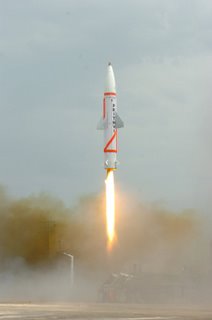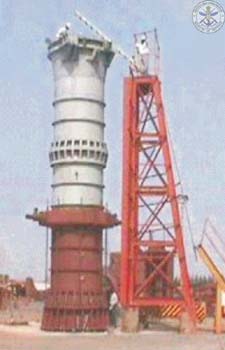India's missile programme: A summary
By Aerospace & Defence Bureau | 30 Jul 2008
 After a long period of development, Indian missile technology has reached a state of maturity that allows the country to field systems and products that cover the entire spectrum of land, air and sea-based platforms. Developed over a period of decades these technologies have been brought to a stage of maturity in the face of overwhelming odds and active technology denial regimes imposed upon it by other countries.
After a long period of development, Indian missile technology has reached a state of maturity that allows the country to field systems and products that cover the entire spectrum of land, air and sea-based platforms. Developed over a period of decades these technologies have been brought to a stage of maturity in the face of overwhelming odds and active technology denial regimes imposed upon it by other countries.
Strategic aim and objectives
It is now acknowledged that outside of the five Nuclear Weapons States, an internationally recognized status conferred by the Nuclear Non-Proliferation Treaty (NPT) upon United States, Russia (as a successor state to the Soviet Union), the United Kingdom, France and China, and also of Israel, India has the most sophisticated ballistic and cruise missile programme in the world.
It is perhaps a travesty that a country so avowedly pacifist in nature should embark upon a programme so markedly militaristic in nature. A short, sharp war with China in 1962 and the subsequent nuclearisation of this country's weapons programme, as well as its cronyism with and encouragement of Pakistan's militray adventures with India left this country with no options but to nuclearise its own weapons programme.
This country cannot erase the insecurity resulting from the nuclearisation of China's weapons programme. Neither can it overlook the simple fact that perhaps more than the four-fifths of its land and sea borders are occupied by or accessible to nuclear weapons-armed powers.
The country's fledgling missile development programme came into existence sometime in1958 and strove to either indigenously develop, or reverse-engineer, technologies of missiles. These projects were undertaken by the Defence Research and Development Organization (DRDO) with the objective of developing scientific expertise and technological infrastructure in the country. The aim was to build modern, indigenously developed missiles in the long term with no immediate plans for serial production of missile systems.
The IGMDP
A decisive shift in missile development plans occurred in 1983, when the Indian government launched the Integrated Guided Missile Development Programme (IGMDP). The programme involved the development of a family of strategic and tactical guided missiles.
Under the strategic programme two ballistic missile systems were to be developed – Prthivi and Agni.
While the Prithvi was to be a short-range ballistic missile, the Agni was to be a medium-range technology demonstrator (TD).
As for tactical guided missile systems, the DRDO sought to develop medium and short-range surface to air missiles (SAMs) the Akash and Trishul, as well as a third-generation anti-tank guided missile (ATGM), the Nag.
The IGMDP programme has recently been brought to a "close". This has now been done as the objectives defined in the original project have been achieved.
Strategic missiles
Prithvi-I/SS-150 (Earth)
The single-stage, liquid-engine 150km-range/1,000kg-payload, army-version, Prithvi-I/SS-150 ballistic missile underwent user trials for the first time in May 2007, with the Indian Army handling the test firing instead of defence scientists. Subsequent to user trials the missile has entered serial production at Bharat Dynamics Limited (BDL), Hyderabad (Andhra Pradesh).
The Indian Army has already raised two missile groups to handle all operational requirements of the Prthvi-I SS-150 version. There are no authoritative estimates of the number of operational Prithvi ballistic missiles in the Army's inventory. Some estimates put the number between 75-90 missiles with the likely acquisition of an additional 30-50.
Prithvi-II/SS-250  The Prithvi-II/SS-250 Indian Air Force (IAF)-version with a range of 250km-range, and a payload of 500kg, was tested in 1993 and inducted in 2004. The IAF's Prithvi-II inventory is variously estimated at about 25, with reports suggesting that the force may acquire an additional 50 numbers.
The Prithvi-II/SS-250 Indian Air Force (IAF)-version with a range of 250km-range, and a payload of 500kg, was tested in 1993 and inducted in 2004. The IAF's Prithvi-II inventory is variously estimated at about 25, with reports suggesting that the force may acquire an additional 50 numbers.
The Indian Army's variant of the Prithvi-II was test-fired for the first time in May 2008 even though it was handed over to the force in 2006. Apparently the Army version has also been tested in a 350 km extended range version.
Prithvi-III/SS-350 – Dhanush (Bow)
The third variant, Prithvi-III/SS-350, version is also referred to as the Dhanush. Its sub-surface variant is the Sagarika/K-15.
The Dhanush/SS-350 has been tested in both ship-based and sub-surface versions. It has been test-fired offshore from ships as well as from underwater canisters substituting for a submarine.
In September 2002, after two successful tests, the DRDO declared that Dhanush was "ready for induction after successful trials at sea." In October 2004, DRDO conducted a successful underwater launch of the Dhanush from submerged canisters.
In November of the same year it also declared an off-shore flight-test from the INS Subhadra a success.
K-15/Sagarika (Oceanic) Another sub-surface version of the Prithvi III, the K-15 or Sagarika, was tested successfully on 26 February 2008. It would appear that the missile had been tested four times previously. The US Department of Defense has categorized it as a submarine-launched ballistic missile though there is some speculation about its cruise missile characteristics.
Another sub-surface version of the Prithvi III, the K-15 or Sagarika, was tested successfully on 26 February 2008. It would appear that the missile had been tested four times previously. The US Department of Defense has categorized it as a submarine-launched ballistic missile though there is some speculation about its cruise missile characteristics.
It appears the missile is meant primarily for induction on the indigenously developed nuclear submarine, the Advanced Technology Vessel (ATV) due to begin sea-trials next year.
The missile, about 6.5 metres in length and weighing seven tonnes, is powered by solid propellants. It can carry nuclear or conventional payloads of about 500 kg and can be launched from different platforms including surface, sub-surface and land mobile launchers.
According to DRDO scientists, February's successful launch nearly completes the country's triad of minimum, credible nuclear deterrence from sea, land and air.
Advanced Air Defence (AAD)
The Prithvi platform has also been configured in an anti-ballistic missile role (Advanced Air Defence) and a modified stage has been used in an "interceptor" mode to bring down an incoming "enemy" missile as part of the country's Ballistic Missile Defence programme. These tests have taken place in November 2006 and December 2007.


.webp)



















